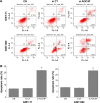Effect of long non-coding RNA AOC4P on gastrointestinal stromal tumor cells
- PMID: 30288061
- PMCID: PMC6163024
- DOI: 10.2147/OTT.S174524
Effect of long non-coding RNA AOC4P on gastrointestinal stromal tumor cells
Retraction in
-
Effect of Long Non-Coding RNA AOC4P on Gastrointestinal Stromal Tumor Cells [Retraction].Onco Targets Ther. 2021 Aug 30;14:4639-4640. doi: 10.2147/OTT.S335829. eCollection 2021. Onco Targets Ther. 2021. PMID: 34511932 Free PMC article.
Abstract
Objective: In this research, we explored the effect of long non-coding RNA (lncRNA) AOC4P on gastrointestinal stromal tumor (GIST) cells.
Materials and methods: The expression of lncRNA AOC4P in tissues was detected by real-time PCR (RT-PCR). The epithelial-mesenchymal transition (EMT)-related proteins in tissues were analyzed by Western blot. The experiment included negative control group (CN), silence AOC4P group (si AOC4P), and silence negative control group (si CT). RT-PCR, MTT, Scratch, Transwell, and Annexin V-FITC methods were used to detect the expression of lncRNA AOC4P, cell proliferation, cell migration ability, cell invasion ability, and apoptosis, respectively. The EMT-related proteins including TGF-β, ZEB1, Vimentin, Snail, and E-cadherin were analyzed by Western blot.
Results: The expression of lncRNA AOC4P and the expression of EMT-related proteins in high-risk GISTs were higher than that in low- and intermediate-risk GISTs (P<0.05). It was revealed that cell proliferative migration and invasive ability in si AOC4P group was decreased than that in CN and si CT groups (P<0.05), and cell apoptosis in si AOC4P group was higher than that in si CT group. The results of Western blot demonstrated that the expression of TGF-β1, ZEB1, Vimentin, and Snail in si AOC4P group were lower than that in si CT and CN group (P<0.05), and the expression of E-cadherin in si AOC4P group was higher than that in si CT and CN group (P<0.05).
Keywords: AOC4P; epithelial-mesenchymal transition; gastrointestinal stromal tumors; long non-coding RNA.
Conflict of interest statement
Disclosure The authors report no conflicts of interest in this work.
Figures








Similar articles
-
Long non-coding RNA AOC4P suppresses epithelial ovarian cancer metastasis by regulating epithelial-mesenchymal transition.J Ovarian Res. 2020 Apr 25;13(1):45. doi: 10.1186/s13048-020-00644-5. J Ovarian Res. 2020. PMID: 32334623 Free PMC article.
-
Long non-coding RNA AOC4P suppresses hepatocellular carcinoma metastasis by enhancing vimentin degradation and inhibiting epithelial-mesenchymal transition.Oncotarget. 2015 Sep 15;6(27):23342-57. doi: 10.18632/oncotarget.4344. Oncotarget. 2015. PMID: 26160837 Free PMC article.
-
LncRNA AOC4P affects biological behavior of gastric cancer cells through MAPK signaling pathway.Eur Rev Med Pharmacol Sci. 2019 Oct;23(20):8852-8860. doi: 10.26355/eurrev_201910_19280. Eur Rev Med Pharmacol Sci. 2019. PMID: 31696472
-
Long noncoding RNA AOC4P regulates tumor cell proliferation and invasion by epithelial-mesenchymal transition in gastric cancer.Therap Adv Gastroenterol. 2019 Feb 19;12:1756284819827697. doi: 10.1177/1756284819827697. eCollection 2019. Therap Adv Gastroenterol. 2019. PMID: 30815034 Free PMC article.
-
AOC4P suppresses viability and invasion and induces apoptosis in NSCLC cells by inhibiting the Wnt/β-catenin pathway.Chem Biol Interact. 2020 Jul 1;325:109110. doi: 10.1016/j.cbi.2020.109110. Epub 2020 Apr 20. Chem Biol Interact. 2020. PMID: 32325081
Cited by
-
Integrated analysis of long non-coding RNAs and mRNAs associated with malignant transformation of gastrointestinal stromal tumors.Cell Death Dis. 2021 Jul 3;12(7):669. doi: 10.1038/s41419-021-03942-y. Cell Death Dis. 2021. PMID: 34218261 Free PMC article.
-
Finding associations in a heterogeneous setting: statistical test for aberration enrichment.Genome Med. 2021 Apr 23;13(1):68. doi: 10.1186/s13073-021-00864-4. Genome Med. 2021. PMID: 33892787 Free PMC article.
-
Non-Coding RNAs, a Novel Paradigm for the Management of Gastrointestinal Stromal Tumors.Int J Mol Sci. 2020 Sep 22;21(18):6975. doi: 10.3390/ijms21186975. Int J Mol Sci. 2020. PMID: 32972022 Free PMC article. Review.
-
Clinicopathological value of long non-coding RNA profiles in gastrointestinal stromal tumor.PeerJ. 2021 Sep 3;9:e11946. doi: 10.7717/peerj.11946. eCollection 2021. PeerJ. 2021. PMID: 34557343 Free PMC article.
-
The Role of lncRNAs in Rare Tumors with a Focus on HOX Transcript Antisense RNA (HOTAIR).Int J Mol Sci. 2021 Sep 21;22(18):10160. doi: 10.3390/ijms221810160. Int J Mol Sci. 2021. PMID: 34576322 Free PMC article. Review.
References
-
- de Vogelaere K, Aerts M, Haentjens P, de Grève J, Delvaux G. Gastrointestinal stromal tumor of the stomach: progresses in diagnosis and treatment. Acta Gastroenterol Belg. 2013;76(4):403–406. - PubMed
-
- Comandone A, Boglione A. The importance of mutational status in prognosis and therapy of GIST. Recenti Prog Med. 2015;106(1):17–22. - PubMed
-
- Mehta C, Gumaste VV, Leytin A, Walfish A. An unusual cause of upper gastrointestinal bleeding: duodenal GIST. A case report and literature review. Acta Gastroenterol Belg. 2011;74(2):347–351. - PubMed
-
- Tiberi L, Faisal A, Rossi M, di Tella L, Franceschi C, Salvioli S. p66(Shc) gene has a pro-apoptotic role in human cell lines and it is activated by a p53-independent pathway. Biochem Biophys Res Commun. 2006;342(2):503–508. - PubMed
Publication types
LinkOut - more resources
Full Text Sources
Research Materials

